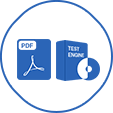Last Update 20 hours ago Total Questions : 268
The Professional Scrum Master I content is now fully updated, with all current exam questions added 20 hours ago. Deciding to include PSM-I practice exam questions in your study plan goes far beyond basic test preparation.
You'll find that our PSM-I exam questions frequently feature detailed scenarios and practical problem-solving exercises that directly mirror industry challenges. Engaging with these PSM-I sample sets allows you to effectively manage your time and pace yourself, giving you the ability to finish any Professional Scrum Master I practice test comfortably within the allotted time.
The Product Owner makes sure the team selects enough from the Product Backlog for a Sprint to satisfy the stakeholders.
Who determines how many Product Backlog items the Developers select tor a sprint? (choose the best answer)
What is the typical size for a Scrum Team?
(choose the best answer)
When many Scrum Teams are working on the same product, should all of their increments be integrated every Sprint?
What is the timebox for a Sprint Planning event? (choose the best answer)
Which statement best describes the Sprint Backlog as outcome of the Sprint Planning?
When does the second Sprint start?

